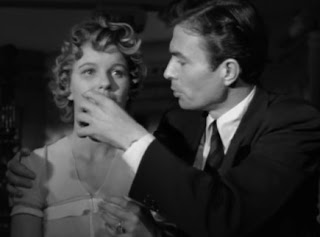A hard-to-come by 40s melodrama that occasionally masquerades as a film noir, CAUGHT had been on my 'to-see' list for years, so I decided to take the plunge when I saw that it was expiring from Netflix instant at the end of the year. A thickly-veiled portrait of Howard Hughes' love life (Ophüls was once fired from a Hughes picture, VENDETTA) and one of Martin Scorsese's favorite films (possibly the reason why he made THE AVIATOR?), the film walks that thin line between high art and low camp (or perhaps between low art and high camp?), and we all know that that's the sort of thing I enjoy.
Ophüls was a German arthouse filmmaker best known for making expressive, French romantic melodramas, packed with exquisite tracking shots. He's at the height of his powers when he's presenting life as a lurid carnival– an endless dance rotating amongst different social milieus, like in LA RONDE or LOLA MONTÉS. He's at his weakest when his carousel remains stuck in a single stuffy mode (i.e., THE EARRINGS OF MADAME DE..., a much-loved film that I happen to dislike). In a film like CAUGHT, he's socially responsible, capturing the moments of life that exist between the stations of life. However, his wings are rather clipped by the studio– he does get some nice tracking shots in there, but visual flair is few and far between. As James Mason later wrote in a poem, "A shot that does not call for tracks/ is agony for poor old Max,/ who, separated from his dolly,/ is wrapped in deepest melancholy./ Once, when they took away his crane/ I thought he'd never smile again."
Basically, the plot follows Barbara Bel Geddes as she tries to further herself by saving up for an education. Don't worry, it's 1949– she's not going to college:

I nearly did a spit-take when she pulls out this brochure after going on about educating and furthering herself. Anyway, after gaining the necessary skill set for obtaining a husband, she marries an oddly named ("Smith Ohlrig") big shot played by noir-standby Robert Ryan, who seems to marry her only to vex his psychiatrist (!?). He turns out to be a raging psychopath, á la Howard Hughes, who must destroy everyone whom he cannot own outright.

Robert Ryan, on the warpath.
Psychological abuse and boredom and melodramatic slapping take their toll

and Bel Geddes' character decides to reject this abusive life of Riley for a more emotionally fulfilling existence in a tenement house, working as a receptionist for a young doctor played by James Mason. It's fun to see him as a caring pediatrician when in retrospect, he carries the cultural baggage of famous roles like "nymphet molester" (LOLITA) and "child murderer" (SALEM'S LOT). At one point he says he'd like to "cut off of the curls" of an irritating, hypochrondriac little girl patient of his. Stay classy, 1949!
James Mason, incredulous.
It sort of turns into stock, well-acted melodrama at this point as she falls for dreamy 'doc Mason while still married to crazytown Ryan, but there were a few happenings that really set it apart:
#1. Robert Ryan's benders that end in bouts of "angry pinball." It seems like the sort of detail that was probably culled straight from Hughes' life. I couldn't verify this in cursory Internet research, but I'm still going with it.
Robert Ryan staves off sexual frustration and sociopathic tendencies with another angry pinball session.
#2. This close-up from a gossip column montage about Ryan and Bel Geddes' declining love life.
Look at the story at the bottom, the one we're supposed to ignore during the course of the scene, because it's not highlighted and has nothing to do with our plot. It appears to involve criminals, a radio show, a former circus clown named "Jebbo," and a volley of bullets. I kind of wanted to be watching this movie!

Though I'm still holding out hope it was Thunderbird!
-Sean Gill





































